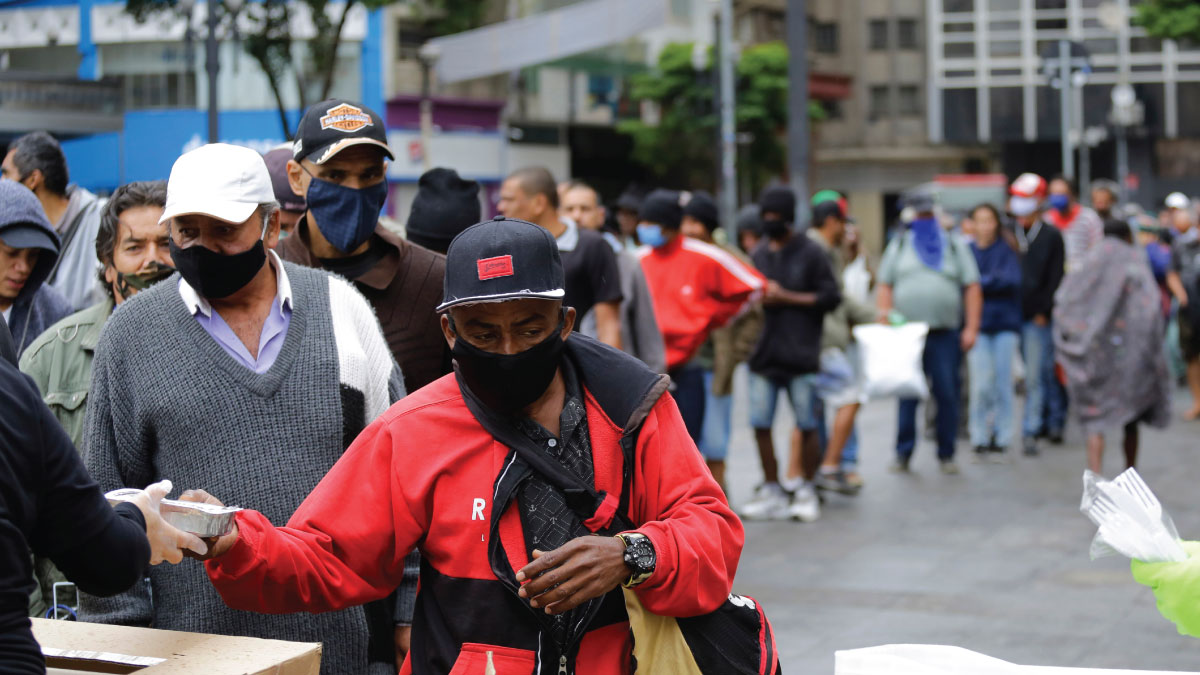Experts propose bold policy ideas and innovative financing instruments to help developing countries build forward better.
© Nelson Antoine/Shutterstock | People wait in line to receive food donations in Sao Paulo, Brazil, due to the economic crisis caused by the COVID-19 pandemic.
The financing needs of developing countries have significantly expanded in recent years, reflected in increased debt accumulation throughout the 2010-2020 period.
This pre-COVID-19 trend placed a major constraint on government responses to confront the urgency of the pandemic and, in the medium-term, restricts their capacity to recover in the face of emerging shocks such as climate disasters and those associated with the conflict in Ukraine.
During a recent workshop held by UNCTAD and the Economic Commission for Latin America and the Caribbean (ECLAC), experts and policymakers identified five critical policy agendas to support economic recovery across developing regions in 2022.
Read an expanded blog about the below policy proposals made at the workshop.
-
Re-channel unused special drawing rights and initiate a new allocation
In August 2021, the International Monetary Fund (IMF) issued $650 billion in new special drawing rights (SDRs), the highest allocation in its history. But about 65% of the SDRs were channelled to developed countries, which don’t use or need them.
The inequality of SDR allocation makes it imperative to efficiently rechannel idle SDRs to developing countries. The first – and fastest – option is a reallocation of unused SDRs within the IMF through their new Resilience and Sustainability Trust (RST), but with conditionality and eligibility issues, the RST needs to be improved and scaled up.
SDRs can also be rechanneled using multilateral development banks, which are already prescribed holders, and regional financial arrangements. Finally, additional allocations of SDRs would be the ideal manner for developing countries to have access to supplementary SDRs as a regular source of development finance.
-
Expand state-contingent debt instruments
The risks attached to a growing stock of debt are often disproportionally borne by borrowing sovereigns. In times of economic, social or climate distress, governments may have no option but to service debt at the expense of supporting the needs of their own populations.
International initiatives have been insufficient to alleviate debt burdens in times of distress, as COVID-19 demonstrates.
Apart from improving external debt relief initiatives, designing state-contingent debt instruments (SCDIs) can help developing countries improve liquidity and debt sustainability in times of crisis and better share risks between borrowers and lenders. Some examples of SCDIs are GDP- (or GNI-) linked bonds, disaster-linked bonds, and hurricane-linked debt clauses.
-
Establish a multilateral credit rating agency
Credit Rating Agencies (CRAs) have long held a powerful yet ambiguous position in international finance as both player and umpire, with profound effects on economic policymaking and investor decisions.
Frustration with CRAs has led to a variety of proposals across different regions for alternatives that can challenge the monopoly of the three major CRAs and refocus priorities on sustainability and financial stability.
One such proposal is for a multilateral credit rating agency that could improve and stabilize credit rating assessment of sovereigns and achieve the Sustainable Development Goals.
-
Increase South-South learning from development banks
The global pool of regional and national public banks includes over 900 institutions overseeing $20 trillion to $49 trillion of assets with accumulated expertise and institutional knowledge.
When the pandemic forced the global economy onto life support in March 2020, governments depended on public banks to deploy their policy responses.
A recent volume released by UNCTAD found a variety of innovative policy tools being deployed across regions, where banks stepped up to the challenge of economic crisis.
While not all banks had the same space to react, the role of Southern-led banks was significant, and indicated new centers of gravity in global public finance.
-
Deploy capital flow management
New research focused on the linkages between large capital inflows and premature deindustrialization has revealed that large capital inflows showed a negative correlation with measures of productive development, highlighting that large capital inflows could lead to reductions in diversification, and signaling the need for capital inflow management.
These findings underline the role of macroprudential policy for transformative post-Covid recovery. With compounded crises on the horizon, multilateral, regional and national strategies must work together for a sustainable and transformative recovery.
The UNCTAD-ECLAC workshop drew on work undertaken as part of a Development Account Project, Response and Recovery: Mobilizing financial resources in the time of COVID.

